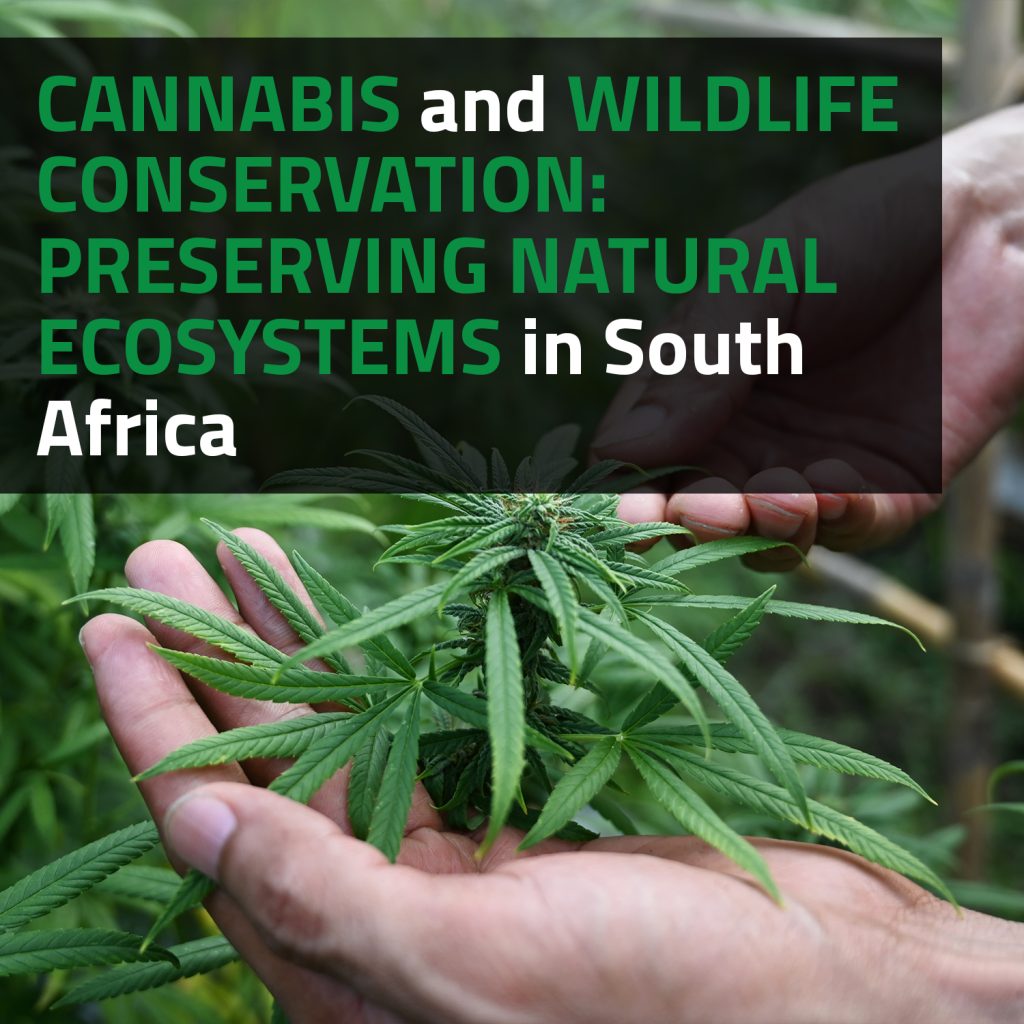In the lush landscapes of South Africa, where biodiversity thrives in a delicate balance, a new challenge has emerged at the intersection of agricultural development and wildlife conservation. The burgeoning South African cannabis industry, with its potential for economic growth, finds itself entangled in a complex web of ecological considerations. As the demand for cannabis cultivation rises, questions arise about its impact on the diverse and unique ecosystems that characterise South Africa.
The Intersection Of Cannabis Cultivation And Natural Ecosystems
Cannabis cultivation, a rapidly growing industry worldwide, has found itself at a critical crossroads with natural ecosystems, particularly in the biodiverse landscapes of South Africa. This intersection raises crucial questions about the environmental impact of cannabis farming on the intricate web of life that characterises the region.
- Biodiversity hotspots: South Africa boasts a wealth of biodiversity, with its unique flora and fauna contributing to several global biodiversity hotspots. The introduction of cannabis cultivation in these areas can potentially disrupt the delicate balance that sustains numerous plant and animal species, some of which may be endemic and endangered.
- Habitat fragmentation: Cannabis cultivation often requires substantial land, leading to habitat fragmentation as natural landscapes are transformed into agricultural plots. This fragmentation poses a direct threat to wildlife migration patterns, breeding behaviours, and overall ecosystem resilience.
- Water usage and quality: Cannabis cultivation, particularly in large-scale operations, can have significant water requirements. In regions where water scarcity is already a concern, this heightened demand may exacerbate existing challenges, affecting both aquatic ecosystems and the surrounding flora and fauna.
- Chemical inputs and soil health: The use of pesticides, fertilisers, and other agrochemicals in cannabis farming can introduce harmful substances into the soil and nearby water bodies. This poses risks not only to the immediate environment but also to the broader ecosystem as these substances can potentially affect non-target species.
- Wildlife disturbance: The establishment of cannabis farms can lead to increased human activity in previously undisturbed areas, potentially causing stress and disturbance to local wildlife. This is particularly relevant in regions where certain species may be sensitive to human presence.
- Erosion and land degradation: Large-scale cannabis cultivation, if not managed sustainably, can contribute to soil erosion and land degradation. This not only affects the productivity of the land for future agricultural use but also has cascading effects on the health of surrounding ecosystems.
Balancing Agricultural Development And Conservation Goals
The coexistence of agricultural development, particularly in the form of cannabis cultivation, with conservation goals poses a complex challenge that requires thoughtful planning, innovative strategies, and collaborative efforts. Achieving a harmonious balance between these seemingly conflicting objectives is essential to sustain both economic growth and the integrity of natural ecosystems.
Sustainable Land Use Planning
Developing a framework for sustainable land use is paramount. This involves identifying suitable areas for cannabis cultivation that minimise the impact on ecologically sensitive zones, such as biodiversity hotspots and critical wildlife habitats. Implementing zoning regulations that guide the location of cannabis farms can help prevent irreversible damage to key ecosystems.
Eco-Friendly Farming Practices
Promoting and incentivising eco-friendly farming practices within the cannabis industry is crucial. This includes adopting organic farming methods, minimising the use of agrochemicals, and employing techniques that reduce soil erosion and nutrient runoff. Sustainable agricultural practices can mitigate negative environmental impacts and contribute to the overall health of ecosystems.
Habitat Restoration And Enhancement
Integrating habitat restoration and enhancement programs into cannabis cultivation initiatives can help offset the ecological footprint of farming activities. This may involve reforestation efforts, the creation of wildlife corridors, and the restoration of degraded landscapes to promote biodiversity and ecosystem resilience.
Community Engagement And Education
Engaging local communities in the conservation process is essential. Educating farmers, industry stakeholders, and the broader community about the importance of biodiversity and the potential consequences of unchecked development fosters a shared understanding of the need for sustainable practices. Community involvement can lead to the development of conservation-conscious farming practices.
Regulatory Oversight And Compliance
Establishing and enforcing robust regulatory frameworks are critical components of achieving a balance between agricultural development and conservation. Clear guidelines on land use, environmental impact assessments, and sustainable farming practices can provide a roadmap for responsible industry growth while protecting vital ecosystems.
Research And Innovation
Investing in research and innovation is key to identifying cutting-edge solutions that benefit both the cannabis industry and conservation efforts. This may include the development of new technologies, cultivation methods that minimise environmental impact, and strategies to enhance the compatibility of agriculture with biodiversity conservation.
Multi-Stakeholder Collaboration
Collaboration among government agencies, environmental organisations, the cannabis industry, and local communities is essential. A multi-stakeholder approach ensures that diverse perspectives are considered, and collective efforts are directed toward finding comprehensive and sustainable solutions that address the interests of all parties involved.
Innovative Approaches To Cannabis Farming For Ecosystem Preservation
Recognising the potential environmental impact of traditional cannabis farming practices, industry stakeholders and conservationists are increasingly exploring innovative approaches to cultivate cannabis while simultaneously preserving ecosystems. These approaches aim to minimise the ecological footprint of cannabis farming and promote sustainable agricultural practices.
Agro-Ecological Farming Methods
Embracing agroecological principles involves designing cannabis farming systems that mimic natural ecosystems. This includes polyculture, where multiple crops are grown together, and agroforestry, incorporating trees and other perennial plants into the cultivation areas. These practices enhance biodiversity, improve soil health, and reduce the need for synthetic inputs.
Precision Agriculture And Technology
Utilising precision agriculture technologies, such as drones and sensors, allows for more efficient and targeted cultivation. This enables farmers to optimise resource use, including water and fertilisers, reducing waste and minimising the environmental impact of cannabis farming. Smart irrigation systems can ensure precise water delivery based on real-time needs.
Cannabis Strain Selection For Eco-Compatibility
Researching and developing cannabis strains that are well-suited to the local climate and soil conditions can contribute to ecosystem preservation. By cultivating varieties adapted to the natural environment, farmers can reduce the need for excessive water, pesticides, and fertilisers, promoting a more harmonious relationship between cannabis cultivation and the surrounding ecosystems.
Closed-Loop Systems And Sustainable Infrastructure
Implementing closed-loop systems in cannabis cultivation involves recycling and reusing resources within the farm. This can include capturing and reusing water, composting organic waste, and creating sustainable energy sources. Integrating green infrastructure, such as living roofs or walls, can further enhance the ecological sustainability of cannabis farms.
Biodiversity Conservation Corridors
Designing cannabis cultivation areas with biodiversity conservation corridors helps connect fragmented habitats. These corridors facilitate the movement of wildlife, maintain genetic diversity, and support ecosystem resilience. They can be planted with native vegetation to create green pathways that benefit both wildlife and the overall ecosystem.
Regenerative Agriculture Practices
Regenerative agriculture focuses on restoring and enhancing the health of the soil and surrounding ecosystems. Practices such as cover cropping, rotational grazing, and minimal tillage can be adapted to cannabis cultivation. These approaches promote soil fertility, reduce erosion, and contribute to the overall ecological sustainability of the farming operation.
Community-Based Conservation Models
Engaging local communities in cannabis farming initiatives and conservation efforts fosters a sense of shared responsibility. Community-based models involve collaborative decision-making, sustainable land use practices, and equitable distribution of benefits. This approach integrates social and economic development with environmental stewardship.
Certification Programs For Sustainable Cannabis
The development and promotion of certification programs for sustainable cannabis cultivation can incentivise farmers to adopt eco-friendly practices. Certification standards may include criteria related to biodiversity conservation, water use efficiency, and adherence to ethical labour practices, providing consumers with assurance of environmentally responsible production.
Cannabis Cloning
Cannabis cloning is gaining recognition as an ecological farming practice due to its potential environmental benefits. Unlike traditional cultivation methods that rely on seeds, cloning involves propagating genetically identical plants from a parent plant. This approach reduces the need for resource-intensive seed production and minimises genetic variation, leading to more predictable and efficient cultivation. Additionally, cloning can contribute to conservation efforts by preserving and propagating specific strains with desirable traits, promoting biodiversity within the cannabis ecosystem. By fostering genetic stability and resource efficiency, cannabis cloning emerges as a sustainable method in the ever-evolving landscape of ecological farming.
In the delicate dance between cannabis cultivation and wildlife conservation in South Africa, the imperative lies in forging a sustainable and mutually beneficial relationship. By embracing agro-ecological methods, precision agriculture, and regenerative practices, stakeholders can chart a course towards environmentally responsible cannabis farming. Collaboration between diverse stakeholders, including government bodies, conservationists, and local communities, is essential for crafting and enforcing regulations that strike a balance between economic development and ecological preservation. As South Africa navigates this dynamic landscape, the integration of innovative approaches into the cannabis industry not only safeguards the nation’s natural heritage but also sets a precedent for sustainable development that resonates globally.










